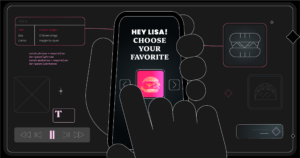If you’re running a business, you know that creating a variety of videos with different purposes is key when it comes to engaging your current and potential customers.
For a start, keep in mind that there are numerous types of videos and video categories to choose from. Choose the types of videos that will allow you to produce content that easily connects and resonates with your audience while promoting your business and its offerings.
That’s why it is important to first dive into the essential types of videos and how to use them to reach your business goals.

Live-Action Videos
Live-action videos are the types of videos that feature real-world footage and often include real people. It’s a popular video style, in part, because of its accessibility.
Live-action videos can vary in quality, from simple smartphone clips to high-end productions. They can also be scripted, such as talking head videos, or unscripted, such as interviews.
Talking head videos
Talking head types of videos feature a person speaking to the camera, whether they are looking directly at it or slightly off to the side in an interview-style format.
These types of videos are great for showcasing an individual’s expertise on a specific topic, which makes them a popular choice for thought leadership content.
Since the focus here is placed on a single person, it’s an effective way to establish a strong and personal connection with the audience.
Vlog videos
When talking head types of videos are produced as a series, they can be considered a vlog, which is essentially a video-based version of a blog where individual videos replace written blog posts.
Vlogs are popular among companies for answering frequently asked questions, sharing updates, and introducing new products. The content for vlogs can be as diverse as it is for traditional blogs, covering a wide range of subjects.
When creating a company vlog or filming talking head videos, it’s essential to consider who will be the face of the content. You may opt to use one individual or a small team that can take turns appearing in each episode.
Interview videos
Interview-style types of videos can be an excellent addition to your video collection and a powerful way to engage your audience and demonstrate your knowledge and expertise in your industry.
These types of videos can be filmed with one fixed camera or multiple cameras for a more dynamic feel. They typically involve an on-camera talking head being interviewed by an off-camera interviewer.
The interviews themselves can cover a wide range of topics, from offering advice and discussing industry trends to showcasing your company culture.
Animated Videos
Animation is a popular and engaging style of video, often used for creating explainer types of videos and brand stories.
Whether it’s as entertaining as a childhood favorite cartoon or as practical as an illustration of a concept, there are numerous different animation styles to choose from, including:
- 2D animation
- 3D animation
- Motion graphics
- Animated typography
- Stop-motion animation
- Whiteboard animation.
2D animation is the most classic-looking style, while 3D animation has a more Pixar-like feel to it. Motion graphics are perfect for explainer videos as they use a clear, minimalist style to illustrate a concept, while animated typography is ideal for videos where the text is the most important element.
Stop-motion animation involves capturing movement one frame at a time using real objects. This style can be achieved with various materials, such as clay or plasticine for claymation, and paper for cut-out animation.
Stop-motion animation often creates a whimsical feel to the animation.
Whiteboard animation is an easy and accessible form of animation that looks like a doodle on a whiteboard. There are numerous low-cost tools available that can enable even those with less artistic ability to create a whiteboard-style video. It’s a great way to engage audiences with its simplicity and creative approach.
Mixed Media
Mixed media types of videos involve the combination of two or more forms of media, such as live-action footage, animation, and stock photography.
These videos provide versatility and creativity and allow for the use of different mediums to convey a message. They can include actors to create a personal connection, animation to clarify concepts, and real screenshots to showcase software features.
The potential applications are vast, and the use of stock footage instead of hiring actors can result in cost-effective and impressive videos.
Screencast Videos
A screencast, which is also referred to as a screen-recorded demo, is among the types of videos that directly records your website, software, or app.
This type of video is an excellent way to showcase your product in action, enabling you to emphasize its benefits and create realistic expectations for potential customers.
Since you’re recording straight from your product, all you need to add is a catchy soundtrack and voiceover, which makes screencasts one of the most cost-effective video types to produce.
Screencasts are versatile types of videos and can be used both before and after a sale. Pre-sale, they’re ideal for demos that allow you to highlight your product’s amazing features and win over customers.
If your product is an app, you can even post the video on the App Store to boost downloads.
Post-sale, screencast videos make excellent tutorials, enabling you to demonstrate how to make the most of your product.
Text Overlay Videos
Video consumption on social media often occurs without sound, with up to 85% of Facebook videos being viewed silently.
As a result, a type of video has emerged that incorporates overlaid text with b-roll and/or still images, often with pan or zoom effects added.
These text overlay types of videos are typically accompanied by background music, which can enhance the story’s impact for viewers who turn on the sound.
Text overlay videos are well-suited for creating how-to content or conveying simple narratives.
Social media-focused publishers like BuzzFeed helped popularize this format, with their Tasty page frequently using it to share recipes. The format involves showing the recipe being prepared in video clips while the ingredients and simple instructions are overlaid as text.
Live Stream Videos
Live streaming is a relatively new and increasingly popular format among the types of videos that you can use to promote your business and its offerings.
Live stream technology enables you to share content with your audience in real-time via social networking platforms such as Facebook and YouTube.
Live stream types of videos are great if you want to stand out in the crowded online space. What’s great about live streaming is that you can save your stream after it ends, so your audience can catch up on what they missed in real-time.
Also, companies have only recently started realizing how great live-streaming sessions can be. Make sure you hop on this trend while it’s on the rise.
Interactive Types of Videos
Interactive videos are a great way for your company to get its audience engaged and involved in the viewing experience. These types of videos offer a level of control that you don’t get with passive watching.
With interactive videos, viewers can make decisions, answer questions, and even buy products without ever leaving the video.
These interactive features are awesome for keeping viewers engaged and on the page longer, which gives you valuable insights into their behavior.
You can use this data to make smarter content and marketing decisions. Interactive videos aren’t just fun, they’re also a practical solution for reaching a diverse group of people.
For instance, a real estate agency could use an interactive video to target two different audiences – potential buyers and sellers.
By creating separate pathways for each group, you can give them the information they need without boring them with stuff that doesn’t apply to them.
360 Degree Videos
Viewers get a more immersive experience with videos that can be seen in 360 degrees since it allows them to observe the video from all different perspectives. This is a clear sign that you need to consider taking advantage of these types of videos.
This type of film is fantastic for showcasing a product since it enables viewers to examine the product in great detail. This not only promotes revenue but also develops trust.
The fact that 360-degree movies can be utilized to conduct a virtual tour also makes them an ideal marketing tool for companies operating in the hospitality industry.
These movies can provide viewers with an engaging experience by presenting the entirety of the scene, which gives them the impression that they are actually present.
Customer Testimonial Types of Videos
Video reviews or testimonials are one of the most effective ways to demonstrate the value of your product or service.
While creating a video about a customer’s experience, it’s necessary to simulate an interview. It is suggested that you ask your customers questions that allow them to express their true opinions regarding your items or services.
This allows you to capture the emotional effect of their event and create a story that seems authentic and real.
The key to creating an effective customer story film is to demonstrate the issues or pain points that your consumer faced before discovering your product or service. This lets you connect with potential customers who may be experiencing similar issues.
By demonstrating how your company’s solution can solve these difficulties, you may demonstrate the value of your product or service in a way that is simple to comprehend and effectively engages potential buyers.
Whiteboard Videos
Whiteboard videos are a type of video that showcases an off-screen illustrator’s hand-drawing graphics that align with a voiceover.
This approach, which involves using a whiteboard, markers, a voiceover, and editing software, is a cost-effective option for businesses with limited marketing budgets.
Whiteboard videos are ideal for conveying concepts and ideas, as the graphics appear in real-time in conjunction with the voiceover.
Final Thoughts
All of these types of videos have their benefits and challenges, as well as different levels of production complexity and costs.
It’s important that you understand how these types of videos fit your business needs if you want to take full advantage of this content form.




